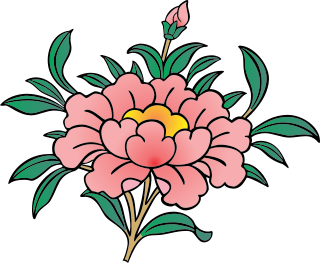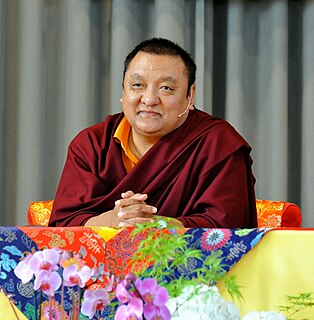Related Research Articles

Tibetan Buddhism is the form of Buddhism practiced in Tibet, where it is the dominant religion. It also has adherents in the regions surrounding the Himalayas, in much of Central Asia, in the Southern Siberian regions such as Tuva, and in Mongolia.

The Sakya school is one of four major schools of Tibetan Buddhism, the others being the Nyingma, Kagyu, and Gelug. It is one of the Red Hat Orders along with the Nyingma and Kagyu.

The Gelug is the newest and currently most dominant sect of Tibetan Buddhism. It was founded by Je Tsongkhapa (1357–1419), a philosopher and Tibetan religious leader. It is known as the Yellow Hat sect. The first monastery he established was named Ganden. The Ganden Tripa is the nominal head of the school, though its most influential figure is the Dalai Lama. Allying themselves with the Mongols as a powerful patron, the Gelugpa have emerged as the pre-eminent Buddhist school in Tibet and Mongolia since the end of the 16th century.

The Kagyu, Kagyü, or Kagyud school, which translates to "Oral Lineage" or "Whispered Transmission" school, is one of the main schools of Himalayan or Tibetan Buddhism. The Kagyu lineages trace themselves back to the 11th century Indian Mahasiddhas Naropa, Maitripa and the yogini Niguma, via their student Marpa Lotsawa (1012–1097), who brought their teachings to Tibet. Marpa's student Milarepa was also an influential poet and teacher.

The Kadam school of Tibetan Buddhism was founded by Dromtön (1005–1064), a Tibetan lay master and the foremost disciple of the great Bengali master Atiśa (982-1054). The Kadampa were quite famous and respected for their proper and earnest Dharma practice. The most evident teachings of that tradition were the teachings on bodhicitta. Later, these special presentations became known as lojong and lamrim by Atiśa.

Mahāmudrā literally means "great seal" or "great imprint" and refers to the fact that "all phenomena inevitably are stamped by the fact of wisdom and emptiness inseparable".

The Jonang is one of the schools of Tibetan Buddhism. Its origins in Tibet can be traced to early 12th century master Yumo Mikyo Dorje, but became much wider known with the help of Dolpopa Sherab Gyaltsen, a monk originally trained in the Sakya school. The Jonang school was widely thought to have become extinct in the late 17th century at the hands of the 5th Dalai Lama, who forcibly annexed the Jonang gompas to his Gelug school, declaring them heretical.

The Shamarpa, also known as Shamar Rinpoche, or more formally Künzig Shamar Rinpoche, is a lineage holder of the Karma Kagyu school of Tibetan Buddhism and is regarded to be the mind manifestation of Amitābha. He is traditionally associated with Yangpachen Monastery near Lhasa.
Buddhist music is music created for or inspired by Buddhism and part of Buddhist art.

The Rimé movement is a movement involving the Sakya, Kagyu and Nyingma schools of Tibetan Buddhism, along with some Bon scholars.
In Tibetan Buddhism, the Red Hat sect or Red Hat sects, named for the colour of the monks' hats at formal occasions, includes the three oldest of the four main schools of Tibetan Buddhism, namely:
Geshe or geshema is a Tibetan Buddhist academic degree for monks and nuns. The degree is emphasized primarily by the Gelug lineage, but is also awarded in the Sakya and Bön traditions. The equivalent geshema degree is awarded to women.

Sakya Monastery, also known as Pel Sakya is a Buddhist monastery situated 25 km southeast of a bridge which is about 127 km west of Shigatse on the road to Tingri in Tibet Autonomous Region.

The imagery of the Refuge Tree, also referred to as Refuge Assembly, Refuge Field, Merit Field, Field of Merit or Field of Accumulation is a key part of a visualization and foundational meditation practice common to Tantric Buddhism. Based on descriptions in the liturgical texts of various traditions, Refuge Trees are often depicted in thangkas employed as objects of veneration, mnemonic devices and as a precursor to the contents being fully visualized by the Buddhist practitioner during the Refuge Formula or evocation.

Dezhung Rinpoche Kunga Tenpai Nyima, born Kunchok Lhundrup, was a Tibetan lama of the Sakya school. Sakya is one of four major schools of Tibetan Buddhism, the others being the Nyingma, Kagyu, and Gelug. In 1960 he came to Seattle, Washington in the United States of America, one of the first Tibetan lamas to settle and teach in the United States.

Katok Tsewang Norbu' was a teacher of the Nyingma school of Tibetan Buddhism) who notably championed the shentong or "empty of other" view first popularised by the Jonang school as well as examining the Chan Buddhist teachings of Hashang Mahayana, known as Moheyan. Despite the shentong view being banned as heretical, he successfully taught and cultivated its teachings as a legitimate view among the Nyingmapa.

Phagmo Drupa Dorje Gyalpo [1110-1170], was one of the three main disciples of Gampopa Sonam Rinchen who established the Dagpo Kagyu school of Tibetan Buddhism; and a disciple of Sachen Kunga Nyingpo [1092-1158] one of the founders of the Sakya school of Tibetan Buddhism. He was the elder brother of Kathog Dampa Deshek [1122-1192], who founded Kathog monastery and the Kathog branch of the Nyingma school.
Ocean of Definitive Meaning: A Teaching for the Mountain Hermit, written in the first half of the 14th century, is considered the magnum opus of Dolpopa Sherab Gyaltsen (1292–1361). The Ocean of Definitive Meaning is a hermeneutical text on the issue of the doctrine of the Three Turnings of the Wheel of Dharma that was first codified in the Sandhinirmocana Sutra.
Buddhism was first actively disseminated in Tibet from the 6th to the 9th century CE, predominantly from India. During the Era of Fragmentation, Buddhism waned in Tibet, only to rise again in the 11th century. With the Mongol invasion of Tibet in the 13th century and the establishment of the Mongol Yuan dynasty, Tibetan Buddhism spread beyond Tibet to Mongolia and China. From the 14th to the 20th Tibetan Buddhism was patronized by the Chinese Ming dynasty (1368–1644) and the Manchurian Qing dynasty (1644–1912).
Rangtong and shentong are two distinctive views on emptiness (sunyata) and the two truths doctrine within Tibetan Buddhism.
References
- 1 2 Newman, Bruce (1 January 2004). A Beginner's Guide to Tibetan Buddhism. Snow Lion Publications. ISBN 9781559398008 – via Google Books.
| | This Tibetan Buddhism-related article is a stub. You can help Wikipedia by expanding it. |